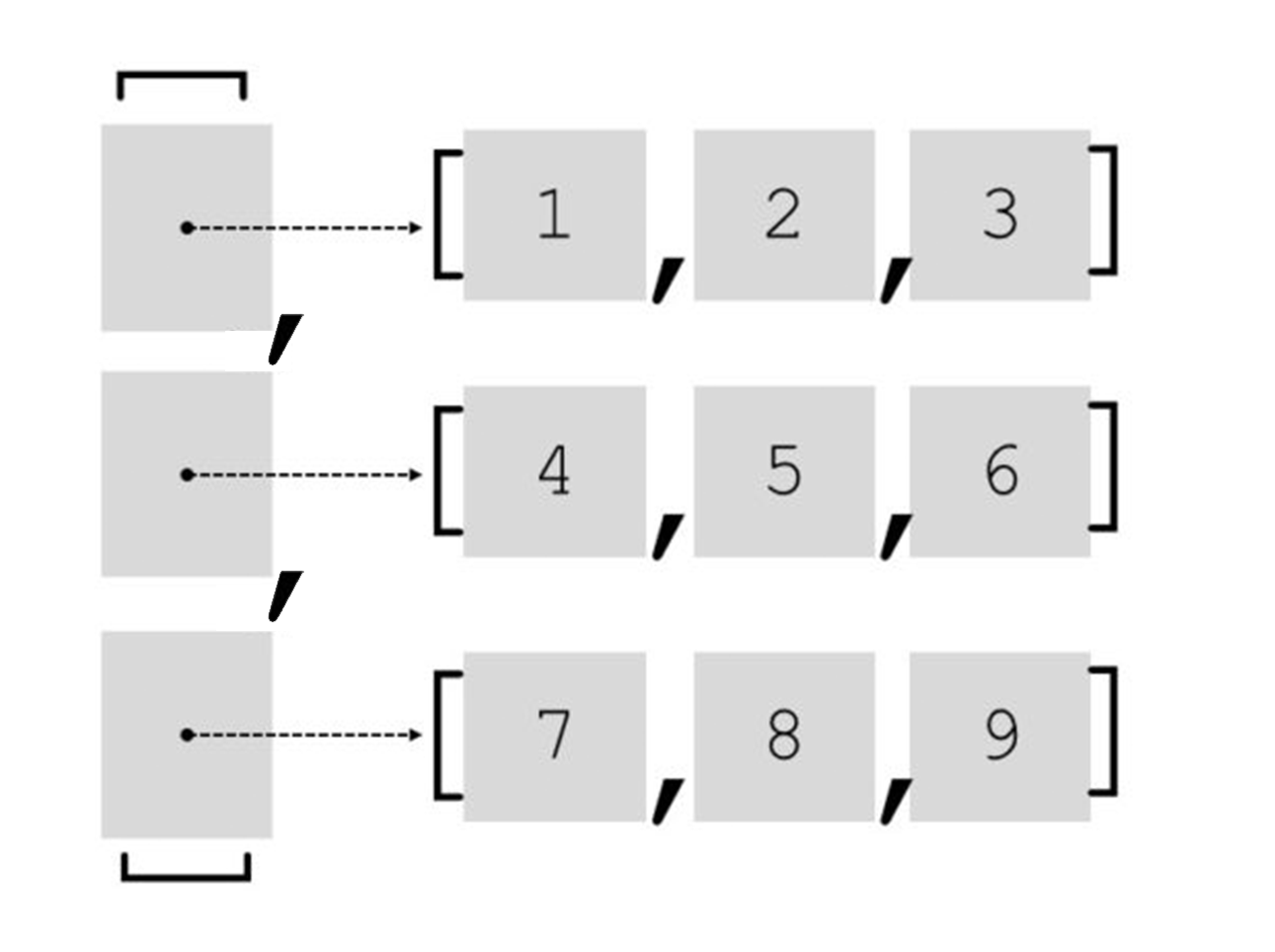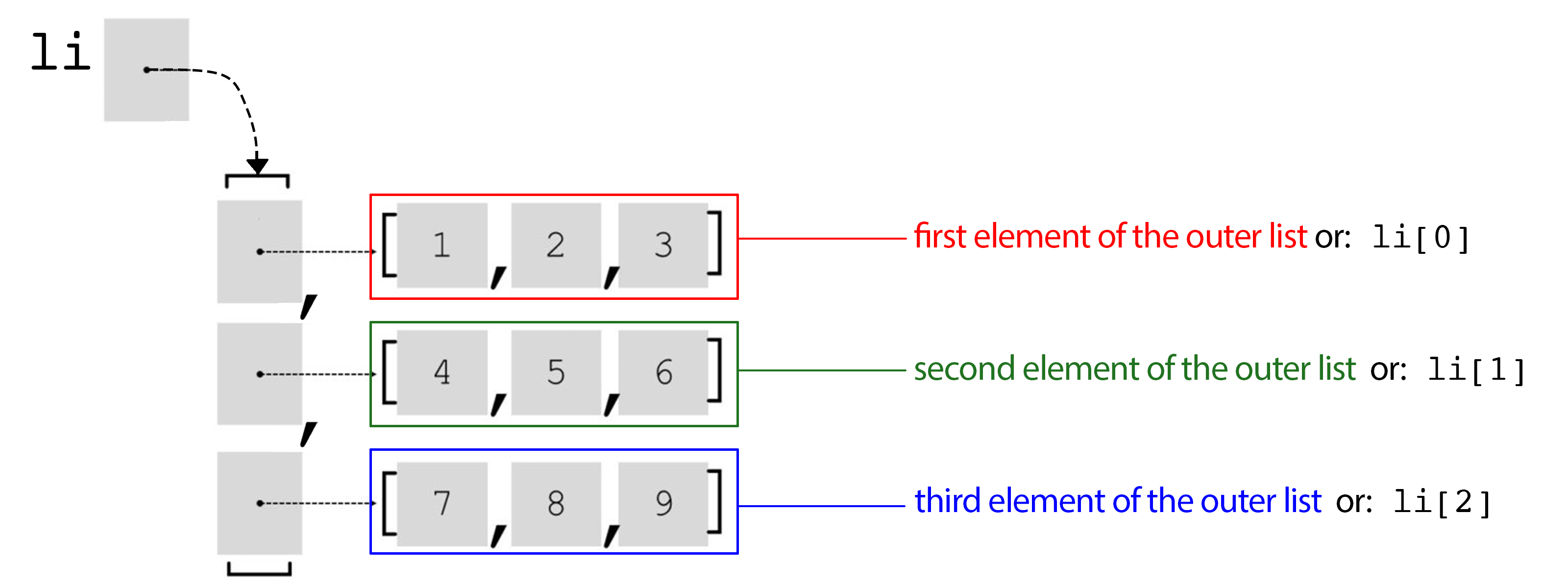Lecture Notes 18: 2D Lists and Nested Loops
Two-Dimensional structures (list of lists)
Imagine the following structre:
|
col 0 |
col 1 |
col 2 |
| row 0 |
"0,0" |
"0,1" |
"0,2" |
| row 1 |
"1,0" |
"1,1" |
"1,2" |
| row 2 |
"2,0" |
"2,1" |
"2,2" |
This structure is showing a
grid of values, each located in a specific row and column (which are marked for clarity).
In that example, the values saved in each location (or
cell) are the value's
coordinates in the grid.
For example, in the following grid (wihtout the extra row and column markins),
| "0,0" |
"0,1" |
"0,2" |
| "1,0" |
"1,1" |
"1,2" |
| "2,0" |
"2,1" |
"2,2" |
the element "1,2" is at:
These types of structures are used all the time (to save data that can be classified under two categories or
dimensions).
Think of "Students vs grades", or "x,y values", or "height vs weight" ratios.
How can we build one?
A list can be composed of the same types of elements (
[1,2,3]) or of different types (
[1, '2', False]).
In this class, we'll mostly use the same type of elements to keep things straightforward.
However, one of the types of things one can save in a list is another list!
In other words, we can have
lists of lists!
The following is an example of a list of lists:
li = [[1, 2, 3], [4, 5, 6], [7, 8, 9]]
print (li)
How to conceptualize this structure?
We need to think of this lists of lists in the following way:
- Thee is a first level to the list: an external list. This is the list of lists
- An element of the external list is itself a list: an inner list
This is a
simplified visualization of how the elements are stored in the list
li:

The following is the same list but with more of its parts explicitly highlighted:

However, when printed on the Python Tutor, the view is less pretty:
Try it Here
Remember, the only important "layout" of the grid is the fact that we have an
outer list with a lot of
inner lists at each location.
Accessing 2D list elements
Since we have outer and inner lists, if we want an inner-list element (example: the element in row 1, column 2), we need to:
- Get the correct element (inner list) from the outer list (the inner list [4, 5, 6] at li[1])
- Get the correct element (number) from the selected inner list (example below)
We can do this in one or two steps:
1
2
3
4
5
6
7
8
9 | li = [[1, 2, 3], [4, 5, 6], [7, 8, 9]]
print (li)
# in two steps
inner_li = li[1]
print("element at outer 1, inner 2:", inner_li[2])
# in one step
print("element at outer 1, inner 2:", li[1][2])
|
Check it out
Here!
We'll work with these grids later today.
Nested Loops
Nested loops are loops done inside of other loops.
They are useful for many reasons, but a clue that we'll probably need one is when you have multiple dimensions to work through:
- For each student, get the average of all their grades
- For each word in a paragraph, check each one of its letters
- For each inner-list in an outer list, print out the inner-list's elements
- etc
Notation for nested loops
There is nothing to add!
You already know how to write a loop, simply write a loop inside a loop!
Combining 2D Lists and Nested Loops
A 2D list is a set of elements that changes in two dimensions (or a two levels).
We'll write a nested loop that prints all the elements inside a 2D list in the "grid pattern".
The Grid Print of a 2D List
Check out the following program:
1
2
3
4
5
6
7
8
9
10
11
12
13
14
15
16
17
18 | def main():
li = [[1, 2, 3], [4, 5, 6], [7, 8, 9]]
print ("ugly print: ", li)
print()
print ("grid print:")
grid_print(li) # prints <argument> levels of numbers
def grid_print(li):
n_rows = len(li)
for row_idx in range(n_rows):
n_cols = len(li[row_idx])
for col_idx in range(n_cols):
print(li[row_idx][col_idx], end=" ")
print()
if __name__ == "__main__":
main()
|
Check it out
Here!
Break and Continue
You can used two reserved words in a loop:
- continue: If you want a loop to skip a section of the body and to continue in the next loop iteration
- break: If you want a loop to stop and never go into the next loop iteration.
Examples:
Check it out
Weird printing of odd numbers
Check it out
Escaping an infinite loop
Lab-like work
You are to build a program that initializes the following 2D-list of values:
This matrix of values represents the grades of 3 students: S1, S2, and S3 on four assignments: A1, A2, A3, and A4.
Use any means you think necessary to:
- Obtain the average grade for each student, and print it out
- Obtain the average grade for each assignment, and print it out
Homework
[Due for everyone]
Assignment 06 will be out Later Today (Due 10/25)
[Optional]
ZyBooks Sections 4.1 - 4.4



